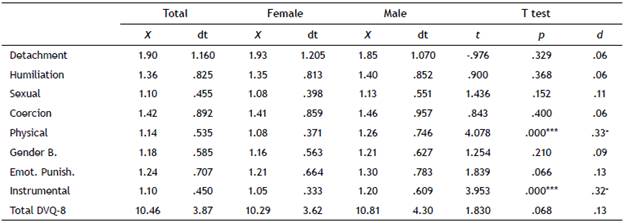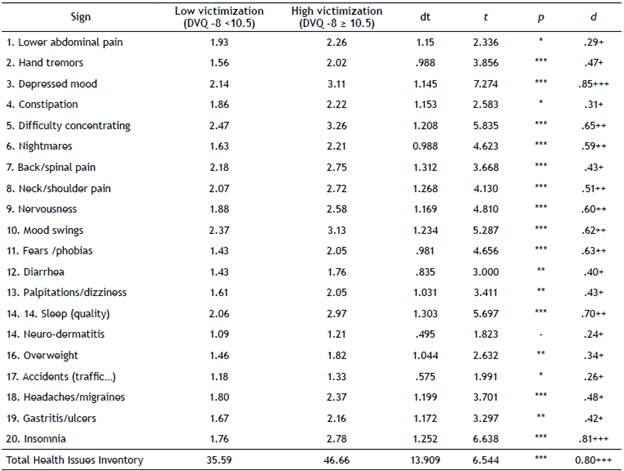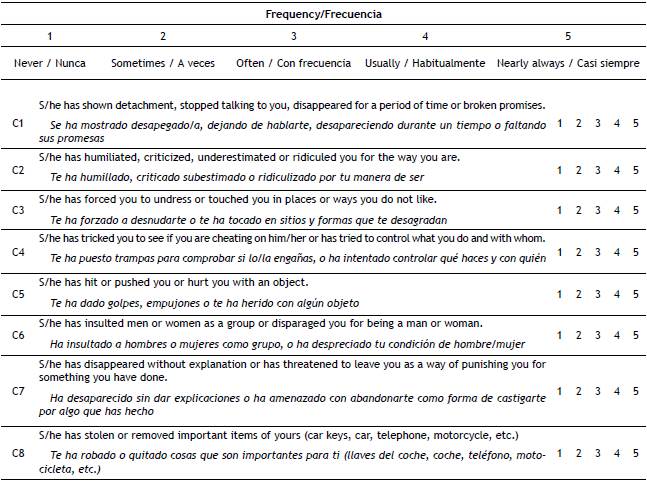The majority of the world's population has engaged, is currently engaged in or will engage in a relationship with at least one sentimental partner during their lifetime. Scien tific literature demonstrates the link between the quality of social relations and a variety of benefits for physical and psychological health in both subjective (e.g. life satisfac tion) and objective terms (e.g. longevity) (Loving & Slatcher, 2013; Uchino, 2006). Nevertheless, partner aggression is a common phenomenon, with ample evidence of its presence existing in various geographical regions, in both sexes, with various sexual orientations and within a broad range of ages (for a review, see Desmarais, Reeves, Nichols, Telford & Fiebert, 2012; Esquivel-Santoveña, Lambert & Hamel, 2013; Langhinrichsen-Rohling, Misra, Selwyn, & Rohling, 2012).
In Mexico, several studies on this issue have been under taken nationwide. Among them, the 2013-2014 State Youth Survey shows that 30% of young people surveyed, both men and women, suffered some type of violence in courtship, mainly psychological (48%), with 10% of respondents suffer ing physical violence (Instituto Mexiquense de la Juventud, 2013). More recently, the National Survey on the Dynamics of Relations in Households was conducted on a sample of women over 15. In this survey, the data reveals that 43.9% of respondents have experienced violence in their current or last relationship (INEGI, 2017). Other studies have been conducted in the region on violence in dating relationships in both the youth (Cortaza, Mazadiego, & Ruiz 2011, Peña et al., 2013, Sosa & Menkes, 2016) and the adult population, (López, Moral, Díaz, & Cienfuegos, 2013) also indicating a high prevalence of violence.
Of all the methods available for evaluating partner vio lence, behavioural instruments constitute the main source of information for sociology, psychology and social work researchers (Costa & Barros, 2016). Although there are sig nificant differences in regards to the number of items, ty pology of violence defined by its scales, groups that may be evaluated (one or both sexes, different or same-sex couples) or assigned roles (aggressive male, female victims) (López-Cepero, Rodríguez-Franco & Rodríguez-Díaz, 2015), validation of these questionnaires has helped professionals gather accumulative and comparable evidence, obtained at different times and from different places (Langhinrichsen-Rohling, 2005).
Even though each evaluation instrument contains an implicit definition of the behaviours and situations consti tuting partner violence, a number of systematic reviews have highlighted the triad comprised of physical, sexual and psychological violence as being the classification most commonly found in the literature (Hays & Emelianchik, 2009; López-Cepero et al., 2015). Nevertheless, behaviours including monitoring, stalking and cyber stalking have led to a prominent fourth category within psychological aggres sions: coercive control (Esquivel-Santoveña et al., 2013). A second, useful classification that overlaps with the pre vious one distinguishes between overt and subtle aggres sion (Jones, Davidson, Bogat, Levendovsky, & von Eye, 2005; Marshall, 1999). Thus, evaluations of partner vio lence should consider aggression in various spheres (sexual, physical...) and modalities (overt and subtle).
However, not all evaluation instruments are designed to provide quantitative results useful for research. In ap plied fields, it is common to find brief instruments designed to identify cases of violence, and screen at-risk people in order to be able to refer them to resources that will per mit more detailed evaluation. Although there is no specific length for differentiating between a screening test and a full evaluation, various reviews propose lengths of 1-11 items to be answered on ordinal scales with 3 to 5 levels of frequency or with dichotomous yes/no answers (Arkins, Bergley, & Higgins, 2016; López-Cepero, 2011).
The capacity for detection is affected by the types of vio lence considered (nearly all the screening methods reviewed evaluate some form of psychological and/or physical vio lence; fewer than half detect sexual aggressions, while only two include evaluations of coercive control; see Table 1). This capacity is also affected by the way the evaluation is applied among youths (self-disclosure is less prevalent in face-to-face interviews, more frequent in written evaluations, and most frequent in computerized tests, Hussain et al., 2015).
Table 1 Screening tools available in the literature
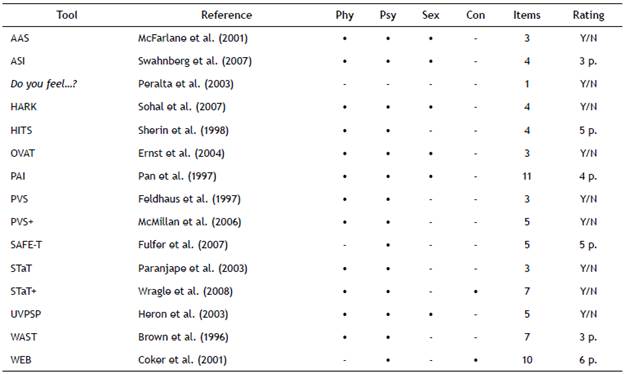
Compiled by the authors (based on Arkins et al., 2016; López-Cepero, 2011). Phy=physical; Psy=psychological/emotional; Sex=sexual; Con=control. AAS=Abuse Assessment Screen; ASI=Abuse Screening Inventory; Do you feel (safe at home)?; HARK=Humiliation, Afraid, Rape and Kick; HITS=Hurt, Insulted, Threatened or Screamed Questionnaire; OVAT=Ongoing Violence Assessment Tool; PAI=Partner Abuse Interview; PVS=Partner Abuse Screen; STaT=Slapped, Things and Threatened; UVPSP= Universal Violence Prevention Screening Protocol; WAST=Woman Abuse Screening Tool; WEB= Women's Experience with Battery Scale. +=expanded form.
The majority of tools that have been validated at least once have been developed for gynaecology, traumatology or emergency services and to assess experiences of victim ization of adult women by the opposite sex (Arkins et al., 2016; Haggerty, Hawkins & Fontenot, 2011), yet none of the validations provide data on the effects of gender on test sensitivity (Arkins et al., 2016).
In light of this overview of the existing literature and given that screening tests are designed to detect abuse during routine processes (such as going to a doctor's appointment), it is striking that no screening instrument has been specifically developed for use in an educational set ting, which could facilitate early detection of victimization. However, long evaluation instruments, with proven validity and reliability, do exist for teenage and youth samples (for a review, see López-Cepero et al., 2015). Among the available instruments, the Dating Violence Questionnaire (Spanish acronym CUVINO); López-Cepero, Fabelo, Rodríguez-Fran co & Rodríguez-Díaz, 2016) has been widely used across Latin-American and Spanish-speaking countries. However, all available tools are fairly lengthy (25 to 42 items), mean ing that they are not ideal for use in early detection or as professional screening tools.
For all these reasons, the objective of this research pro ject is to develop a short evaluation tool, based on DVQ, suitable for application to both sexes in a community set ting, and to provide empirical evidence on its validity and reliability.
Study 1. Structure and reliability of Dating Violence Questionnaire - 8
Method
Participants. The first study included 990 university stu dents from a public university in Jalisco (Mexico), a metro politan area with over 4.5 million inhabitants (INEGI, 2010). All the participants were adults, aged between 18 and 26 (X=19.5; dt=1.82 years). The sample group was two thirds women and one third men (66% and 34%, respectively). All subjects signed consent forms after being informed of the study goals.
Instruments. This study obtained information from two questionnaires: a socio-demographic information sheet (including the sex and ages of the respondent and his/ her current or most recent partner), and the DVQ-8, a re duced version of the Dating Violence Questionnaire (DVQ; Cuestionario de Violencia de Novios -CUVINO in its origi nal, Spanish version; López-Cepero et al., 2016). This eight-item instrument includes the fusion of contents from the eight scales found in previous DVQ validations (detachment, humiliation, sexual violence, coercion, physical violence, gender-based violence, emotional punishment, instrumen tal punishment), to be answered on a frequency scale of five levels (from 1=never to 5=nearly always). The DVQ-8 is therefore a screening instrument for routine evaluation. This instrument is included in the appendix.
Procedure. Participants provided information on their most recent (preferably current), stable (longer than one month) dating relationship. The evaluation was conduct ed through a web application, which provided information on the voluntary, anonymous and confidential nature of the study before proceeding to collect data. The link to the application was sent to students in the Social Work and Psychology Faculties. Contact information was provided to clarify any doubts that might arise at the time or later.
Two researchers who had participated in the valida tion of the original Spanish version of the DVQ (CUVINO, in Spanish) helped create the DVQ-8 in order to maximize the representativeness of its content (Rodríguez-Franco et al., 2010). Two consultants with extensive professional ex perience in the state of Jalisco also participated in order to adapt the phrasing of the items to the local context.
As for the statistical analyses, this study involved un dertaking descriptive procedures (central tendency and dispersion measures and distribution analysis), comparative measures (Student T tests for independent groups, robust when the distribution does not fit normal distribution; *p<.05) and an estimation of effect size through d (Cohen, 1988; negligible for values d<.20; small d<.50; moderate d<.80; large for d=.80 or over); obtained through SPSS Statistics 24. An exploratory factor analysis (EFA) was developed with version 10.3 of FACTOR software (Lorenzo-Seva & Ferrando, 2015), using parallel analysis based on polychoric matrices and Promin oblique rotation in two different steps. The first step was intended to determine the recommended number of factors, and the second to extract the factorial weights and goodness of fit to the factorial structure (in keeping with the recommendations by Ferrando & Lorenzo-Selva, 2014). FACTOR provided EAP alpha reliability indices for the scale, suitable for ordinal data (EAP alpha > .700; Ferrando & Lorenzo-Seva, 2016).
Results
An exploratory factor analysis was conducted to estab lish the internal structure of the DVQ-8, for both the whole sample, and men and women separately. In every case, FACTOR indicated that the solution of a single general fac tor was the best option for reaching suitable indicators of fit (Kaisser-Meyer-Olkin statistics equal to or over .85 and Global Fit Index-GFI=.99 in all cases). The factor, called partner violence, established high internal consistency (EAP alpha >.900) for the total test group as well as separately for men and women (Table 2).
Table 2 Exploratory factor analysis for DVQ-8 in total sample, and by sex.
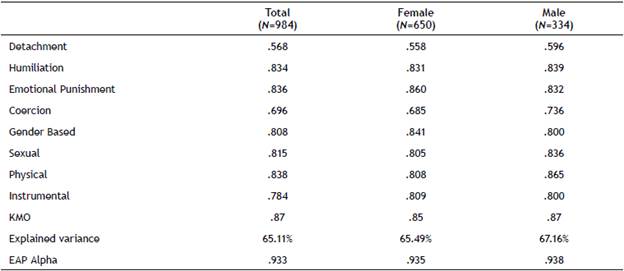
***p<.001; +d =small effect size.
A descriptive analysis was undertaken for measurements obtained by each item, both for the total test group, and for men and women separately. By means of a T test for independent samples (without assuming the equality of variances), statistical similarity was corroborated in the ex perience of victims of both sexes for six of the eight types of violence. In the case of physical and instrumental vio lence, a slightly higher mean was found among men; with a small effect size (d>0.20). Total victimization was statis tically similar for both groups, with a negligible effect size (d=.13). This information is shown in Table 3.
Study 2: concurrent and criteria validity for Dating Violence Questionnaire - 8
Method
Participants. A total of 355 students at the universi ty described earlier participated in a second study. Their average age was X=20.2 years (dt = 1.80) and 75% were fe male. Just over half the participants (52.7%) provided infor mation on a current relationship.
Instruments. These were administered in four segments: The socio-demographic data sheet (described in study 1), the DVQ-8 (idem), a section on self-labelling the experience, and an inventory of prevalent symptoms and pathologies among university students (Health Issues Inventory-HII).
Information on labelling one's own experience was ob tained in keeping with the method described by López-Cepero et al. (2016). This study only analysed information from one of the available labels: Have you felt or do you feel mistreated? The question was answered on a five-level frequency scale (1= never, 5= almost always). Answers were classified into two levels: negative (never) and positive (sometimes/ often/ usually/ nearly always).
Lastly, a scale was administered to measure the occur rence of health issues throughout the partner relationship, selected from those proposed by Reig, Cabrero, Ferrer & Richart (2001). The inventory included 20 items (e.g. How frequently do/did you suffer from headaches? ...lower abdominal pain? ...pain in your neck and shoulders? These questions were answered on a five-level frequency scale (1 = never, 5= nearly always). During its validation with Mex ican university students, the HII showed a single factor structure, with an estimated statistical reliability of .949 (Macías-Pérez, 2017). The EAP alpha value achieved a value of .923 in this study.
Procedure. The sampling method was identical to that described in study 1, albeit with a different group of stu dents. We asked participants to report on their current or most recent relationship. Statistical procedures included: descriptive analyses, comparison of averages (Student T tests for independent sample groups), C contingency coeffi cient for cross-tabulation (*p<.05) and estimated percentag es of cases classified on the ROC curve (Receiver Operating Characteristic; *p<.05) using SPSS Statistics 24.
Results
The second study analysed the relation between scores from the DVQ-8, and the self-labelling of the mistreatment and health problems experienced by participants in their relationships.
First of all, a comparison was made of the averages for groups labelled as mistreated (25.8% of positive cases). Giv en the similar levels of victimization reported by men and women, analyses were conducted for the entire sample. The T test corroborated that people who labelled themselves as mistreated in their relationship obtained higher statistical averages for all forms of violence evaluated by the DVQ-8, with a large effect size for the whole scale (Table 4).
Table 4 Comparison of averages for groups with and without mistreatment (without assuming equal variances).
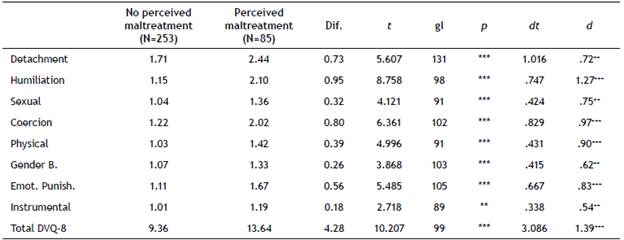
*p<.05; **p<.01; ***p<.001. d = size effect ++moderate; +++large.
In order to establish a cut-off point to act as a risk marker, the ROC classification curve was analysed for the mistreatment label (positive or negative) in terms of the victimization experienced (area under curve = .890; ***p < .001). Joint analysis of the correct classification of pos itive (sensitivity) and negative cases (specificity) showed that a cut-off point of between 9.5 and 10.5 points permit ted correct categorization in a similar percentage of cas es (approximately 80%). Establishing 9.5 as the golden rule enabled us to maintain a high percentage of true positives, yet with discrete specificity and 47% of participants pro posed as potential victims. A cut-off point of 10.5 obtained a higher percentage of correct classification (81%), with 30.8% of positive cases (see Table 5). The proportion of pos itive cases was similar in both sexes (C = .056; p = .306).
Table 5 “Mistreatment” label classification percentages for DVQ-8 results.

CP = cut-off point; Sens.=Sensitivity; Sp.=Specificity. Recommended cut-off point = 10.5
Lastly, the relationship between victimization and health issues described by the respondents was tested. As regards correlation, the existence of a positive and signif icant relationship was proven between total victimization (DVQ-8) and health problems experienced (HII) (Spearman's Rho = .418; ***p < .001). A comparison was also made of the health problems among the two groups in relation to their DVQ-8 scores: below 10.5 (regarded as negative cases) and 10.5 and over (regarded as positive cases). In the T test, the group of positive cases showed a greater prevalence in 19 of the 20 signs and symptoms evaluated (*p < .05; d = [.24-.81]). For the total HII score, these differences were significant (***p < .001 and large size (d=.80). In terms of the possible effect of the respondent's sex on results, a greater rate of symptomatology was found in the female group rather than the male group (**p = .007; d = .39); significant differences were also corroborated between the groups defined by the DVQ-8, with a moderate-sized effect among women (***p < .001; d = .67) and a large effect size among men (**p < .01; d = 1.10). These figures are included in table 6.
Conclusions and discussion
The main purpose of this study was to provide psycho metric information on a new measurement instrument, the DVQ-8, designed for the screening and early detection of vi olence in young couples in educational settings. The explor atory factor analysis, developed on the basis of Ferrando and Lorenzo-Seva's proposal (2014), showed the existence of a single factor that was able to explain more than 65% of the variance, with a reliability rate of over .900. Moreover, the ROC curve analysis allowed for a cut-off point that correctly classifies approximately 80% of cases (both positive and negative). These results were valid for both men and women, addressing a challenge mentioned in previous liter ature (Arkins et al., 2016).
Evidence of the instrument's validity rests on three pil lars. First of all, the DVQ-8 is based on a previously val idated tool, in which the definition of violence includes both physical and sexual violence, coercive control, and various forms of psychological violence, both direct and in direct, meeting the needs raised in the literature (Esquivel-Santoveña et al., 2013; Marshall, 1999). The second is that levels of sensitivity and specificity were similar to or greater than those described by other more commonly used tools such as self-reports and the golden rule (Arkins et al., 2016).
The third is that the groups defined by the selected cut off point (10.5) showed large, significant differences in the health problems experienced by the participants, pointing to a direct relationship between victimization and negative health outcomes.
An analysis of the frequency of victimization detected by the instrument yields two conclusions. The first is that the most frequent type of abuse (detachment and coer cion) corresponds to less direct (subtle) aggression. More direct (overt) violence (physical and sexual), however, is more easily recognized, yet less common. These results co incide with the findings of the complete version of the DVQ (López-Cepero et al., 2016; Rodríguez-Franco et al., 2010) and underscore the need to include information on more subtle types of violence in prevention and awareness cam paigns. Detection of these subtle types of violence allow re lationships to be terminated before they escalate into abu sive relationships. Secondly, the statistical similarity found for both sexes is striking. These results are compatible with those described in the literature as useful for research un dertaken in sample communities (as opposed to selected samples such as those obtained from shelters for abuse sur vivors or penitentiary centres; Langhinrichsen-Rohling et al., 2012). However, and beyond discussing the different im plications of abuse for men and women, these findings high light a matter of concern: the high percentage of people who engage in relationships in which interactions include violence. Even if we begin with the premise that violence has a lower impact on men, the fact that they participate in relationships in which scorn, control and blows are used implies a risky context for the development of unhealthy re lationships. This information should therefore serve as the basis for developing preventive intervention methods for a broad population spectrum.
This study has a number of constraints that may make it difficult to generalize its conclusions. First, participants were drawn from a single geographical location (Central Mexico), meaning that further studies in other regions are required in order to prove the invariance of the findings. Likewise, all the participants were enrolled at university, thereby excluding adolescents and other young adults who are unable to access higher learning from participating in the study. Nevertheless, these limitations are offset by the following: (1) the percentage of young adults enrolled at this level of education in Mexico has increased rapidly over the past two decades (from 10% to 16% in the last INEGI eval uation, 2010) and (2) most screening instruments are used in specific hospital settings, where the percentage of the population attended is probably lower than that of the ed ucation sector.
A closer look at the contributions of this study shows that the DVQ-8 has yielded good psychometric evidence in a wide range of young adults, both men and women (who share a cut-off point), regardless of the participants' sexu al orientation, which is not covered by other tools (Arkins et al., 2016). Likewise, the DVQ-8 offers separate indica tors for the primary types of aggression including sexual, physical and psychological violence, coercive control, and subtle forms such as detachment and emotional punishment overlooked in earlier instruments. Thus, even though this text focuses on the usefulness of the tool for screening, the quantitative results of the DVQ-8 could also be used to shape the contents of an intervention program for specific groups (e.g. a class), or even as a brief (although valid and reliable) option for evaluating victim experiences for re search projects in which dating violence is relevant, but not central.
For all the above reasons, the DVQ-8 contains sufficient guarantees to be included in professional use by educators to screen for high-risk cases at a low cost. It permits the early detection of victimization in young couples and makes it easier to refer victims to resources that could help them resolve their situation quickly and safely.













